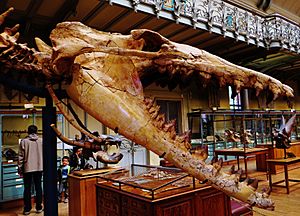Cynthiacetus facts for kids
Quick facts for kids Cynthiacetus |
|
|---|---|
 |
|
| Skeleton at the MNHN, Paris | |
| Scientific classification |
|
| Kingdom: | Animalia |
| Phylum: | Chordata |
| Class: | Mammalia |
| Order: | Artiodactyla |
| Infraorder: | Cetacea |
| Family: | †Basilosauridae |
| Subfamily: | †Dorudontinae |
| Genus: | †Cynthiacetus |
| Species | |
|
|
Cynthiacetus is an extinct genus of basilosaurid early whale that lived during the Late Eocene (Bartonian-Priabonian, 40.4 to 33.9 million years ago.) Specimens have been found in the southeastern United States and Peru (Otuma Formation).
Description

Cynthiacetus was named after the town of Cynthia, Mississippi, close to where the type specimen for the species C. maxwelli was discovered.
The skull of C. maxwelli was similar in size and morphology to that of Basilosaurus cetoides, but Cynthiacetus lacked the elongated vertebrae of Basilosaurus. erected the genus to avoid the nomen dubium Pontogeneus (which was based on poorly described and now vanished specimens). Cynthiacetus was smaller than Masracetus.
The South American species C. peruvianus, the first archaeocete to be described on that continent, mainly differs from C. maxwelli in the number of cuspids in the lower premolars, but it also has the greatest numbers of thoracic vertebrae (20). The type specimen of C. peruvianus belonged to an adult individual measuring 9 m (30 ft) long.
See also
 In Spanish: Cynthiacetus para niños
In Spanish: Cynthiacetus para niños

